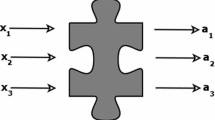Abstract
The application of the conceptual analysis (CA) method outlined in Part I is illustrated on the example of quantum mechanics. In Part II, we deduce the complete-lattice structure in quantum mechanics from postulates specifying the idealizations that are accepted in the theory. The idealized abstract concepts are introduced by means of a topological extension of the basic structure (obtained in Part I) in accord with the “approximation principle”; the relevant topologies are not arbitrarily chosen; they are fixed by the choice of the idealizations. There is a typical topological asymmetry in the mathematical scheme. Convexity or linear structures do not play any role in the mathematical methods of this approach. The essential concept in Part II is the idealization of “perfect measurement” suggested by our conceptual analysis in Part I. The Hilbert-space representation will be deduced in Part III. In our papers, we keep to the tenet: The mathematical scheme of a physical theory must be rigorously formulated. However, for physics, mathematics is only a nice and useful tool; it is not purpose.
Similar content being viewed by others
References
F. Jenč.Phys. 9, 589 (1979).
F. Jenč, Research report NMP 13 (1974); 2nd printing (with comments) (1975).
G. Szász,Introduction to Lattice Theory, 3rd ed. (Academic Press, New York, 1963).
G. Birkhoff,Lattice Theory (Amer. Math. Soc. Coll. Publ. V.XXV, American Mathematical Society, Providence, 1948).
M. L. Dubreil-Jacotin, L. Leisieur, and R. Croisot,Leçons sur la théorie des treillis des structures algébriques ordonnées et des treillis géométriques (Gauthier-Villars, Paris, 1953).
J. M. Jauch and C. Piron,Helv. Phys. Acta 42, 842 (1969).
C. Piron,Found. Phys. 2, 287 (1972).
C. Piron,Foundations of Quantum Physics (Benjamin, Reading, 1976).
G. Ludwig,Lecture Notes in Physics 4 (Springer, Berlin, 1970).
J. C. T. Pool, Thesis, State University of Iowa (1963), Rept. No. SUI-63, 17.
C. Piron,Helv. Phys. Acta 42, 330 (1969).
N. Zierler,Pac. J. Math. 11, 1151 (1961).
R. V. Kadison, Unpublished result, quoted in G. W. Mackey,The Mathematical Foundations of Quantum Mechanics (Benjamin, New York, 1963).
N. Bourbaki,Élements de mathématique, Partie I. Livre III. Topologie générale (Hermann, Paris, 1965).
H. Schubert,Topologie (Teubner, Stuttgart, 1964).
N. Dunford and J. T. Schwartz,Linear Operators. Part I (Interscience, New York, 1958), Chapter I.
Author information
Authors and Affiliations
Additional information
Dedicated to Prof. G. Ludwig on the occasion of his sixtieth birthday.
Rights and permissions
About this article
Cite this article
Jenč, F. The conceptual analysis (CA) method in theories of microchannels: Application to quantum theory. Part II. Idealizations. “Perfect measurements”. Found Phys 9, 707–737 (1979). https://doi.org/10.1007/BF00711105
Received:
Issue Date:
DOI: https://doi.org/10.1007/BF00711105




